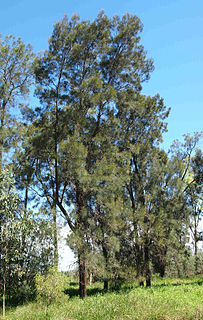Bendidee is a national park in the Goondiwindi Region, Queensland, Australia.
Blackwood is a national park in the Charters Towers Region, Queensland, Australia.
Expedition is a national park in Queensland, Australia, 490 km northwest of Brisbane. It is named for the Expedition Range of mountains.
Southwood is a national park in Queensland, Australia, 288 km west of Brisbane.
Epping Forest is a national park in Queensland, Australia, 855 km northwest of Brisbane. The park is a scientific national park so it is not open to the public. Only scientists, rangers and volunteers may visit the park. The park lies within the Brigalow Belt North bioregion. It is within the Drummond Basin geological basin and the Belyando River water catchment area. The park was established to protect a species of wombat that is the world’s largest burrowing herbivore.
Taunton National Park is situated near the town of Dingo approximately 135 km inland from Rockhampton in eastern Central Queensland, Australia. The park encompasses an area of 11,626 ha within the Northern Brigalow Belt bioregion of Queensland; a region widely recognised to contain considerable biodiversity.

Acacia harpophylla, commonly known as brigalow, brigalow spearwood or orkor, is an endemic tree of Australia. The Aboriginal Australian group the Gamilaraay peoples know the tree as Barranbaa or Burrii. It is found in central and coastal Queensland to northern New South Wales. It can reach up to 25 m (82 ft) tall and forms extensive open-forest communities on clay soils.

Brachychiton rupestris, commonly known as the narrow-leaved bottle tree or Queensland bottle tree, is a tree in the family Malvaceae native to Queensland, Australia. Discovered and described by Sir Thomas Mitchell and John Lindley in 1848, it gained its name from its bulbous trunk, which can be up to 3.5 metres (11 ft) diameter at breast height (DBH). Reaching 10–25 metres (33–82 ft) high, the Queensland bottle tree is deciduous, losing its leaves between September and December. The leaves are simple or divided, with one or more narrow leaf blades up to 11 centimetres (4 in) long and 2 centimetres (0.8 in) wide. Cream-coloured flowers appear from September to November, and are followed by woody boat-shaped follicles that ripen from November to May. No subspecies are recognised.

Acacia cambagei, commonly known as gidgee, stinking wattle, stinking gidgee in English, or gidjiirr, by transliteration from indigenous languages of north-western NSW, is an endemic tree of Australia. It is found primarily in semiarid and arid Queensland, but extends into the Northern Territory, South Australia and north-western New South Wales. It can reach up to 12 m in height and can form extensive open woodland communities. The leaves, bark, and litter of A. cambagei produce a characteristic odour, vaguely reminiscent of boiled cabbage, gas or sewerage that accounts for the common name of "stinking gidgee".

Brigalow is a rural town and locality in the Western Downs Region, Queensland, Australia. In the 2016 census the locality of Brigalow had a population of 170 people.

The Brigalow Belt is a wide band of acacia-wooded grassland that runs between tropical rainforest of the coast and the semi-arid interior of Queensland, Australia. The Interim Biogeographic Regionalisation for Australia (IBRA) divides the Brigalow Belt into two IBRA regions, or bioregions, Brigalow Belt North (BBN) and Brigalow Belt South (BBS). The North and South Brigalow Belt are two of the 85 bioregions across Australia and the 15 bioregions in Queensland. Together they form most of the Brigalow tropical savanna ecoregion.

Hopeland is a rural locality in the Western Downs Region, Queensland, Australia. In the 2016 census, Hopeland had a population of 140 people.

Eucalyptus cambageana, commonly known as the Dawson River blackbutt, Dawson gum or Coowarra box, is a species of tree that is endemic to Queensland, Australia. It is a medium-sized tree with hard, rough bark on the lower trunk, smooth white to cream-coloured bark above, lance-shaped or curved adult leaves, flower buds in groups of seven, white flowers and cup-shaped to funnel-shaped fruit.

Casuarina cristata is an Australian tree of the sheoak family Casuarinaceae known as belah. It is native to a band across inland eastern Australia.

Denhamia oleaster is a shrub or small tree within the family Celastraceae, endemic to Queensland. The species inhabits a variety of environments, from monsoon forest to semi-arid savanna and occurs on a broad range of soil types. In more humid locales the species can grow to 6 metres in height, although it may not reach more than 1 metre in less favourable environments.

Boea is a genus of plants in the family Gesneriaceae, with species originating from Australia, China, India, Malaysia, Birma, Philippines, Polynesia, Solomon Islands, Thailand, Papua New Guinea, Indonesia, Nepal, Bhutan, Cambodia, Vietnam and Laos.
Beeron National Park is a national park at Beeron in the Wide Bay–Burnett region of Queensland, Australia. The 7050-hectare park preserves plant species of high conservation value. It was formerly known as Beeron Holding or 'Rocky' paddock.
Xerothamnella is a genus of flowering plants in the family Acanthaceae, native to Queensland, Australia. A molecular study shows that it is nested within Peristrophe.
The Weeping Myall Woodlands is an endangered ecological community, under the EPBC Act of the Commonwealth of Australia. It is found in inland Queensland and inland New South Wales, on alluvial plains west of the Great Dividing Range. It takes its name from Acacia pendula, the weeping myall.
Xerothamnella parvifolia, also known as the Small-leaved Little Dry Shrub, is a species of plant in the acanthus family that is endemic to Australia.










